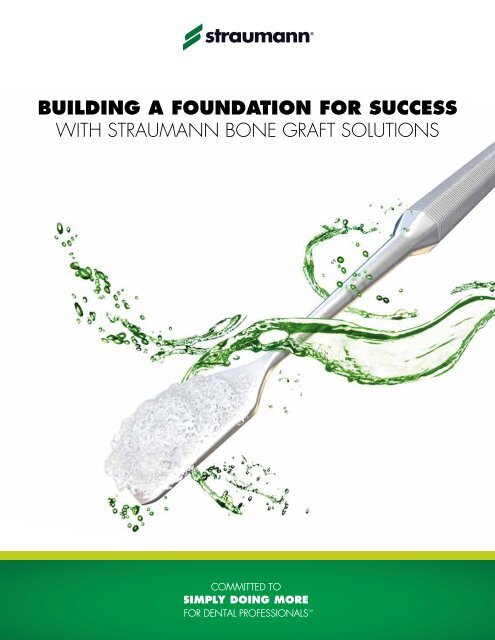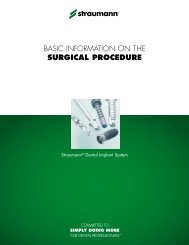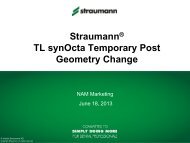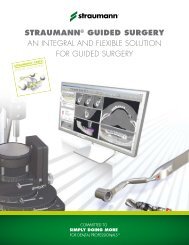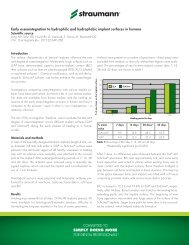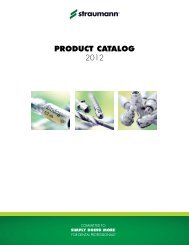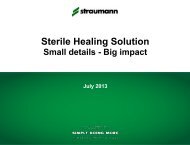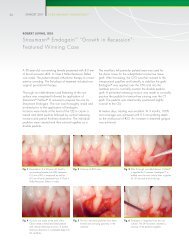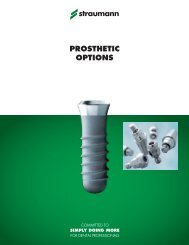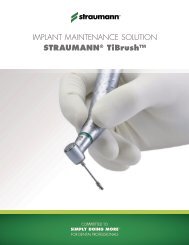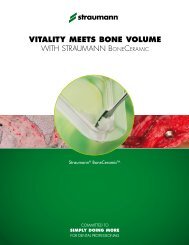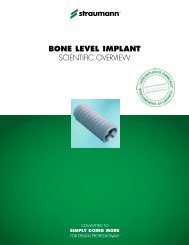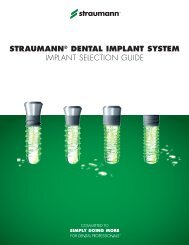Straumann Bone Graft Solutions
Straumann Bone Graft Solutions
Straumann Bone Graft Solutions
You also want an ePaper? Increase the reach of your titles
YUMPU automatically turns print PDFs into web optimized ePapers that Google loves.
Building a Foundation for Success<br />
with <strong>Straumann</strong> <strong>Bone</strong> <strong>Graft</strong> <strong>Solutions</strong>
Regenerate the patient’s own vital bone<br />
Vital bone tissue is the key component needed to build a foundation for success – whether it’s the osseointegration of a dental<br />
implant or the functional regrowth of periodontal structures.<br />
<strong>Straumann</strong> ® <strong>Bone</strong> <strong>Graft</strong> <strong>Solutions</strong> provide you with a choice of quality products designed to support the regeneration of the patient’s<br />
own vital bone for hard and soft tissue augmentation procedures.<br />
Clinical situation<br />
after tooth extraction<br />
<strong>Graft</strong>ing with <strong>Straumann</strong><br />
Ground Cortical Allo<strong>Graft</strong><br />
Clinical situation at re-entry<br />
after 5 months healing time<br />
Photos courtesy of Robert Miller, DMD, Fort Lauderdale, FL<br />
Your choice of bone graft substitute<br />
should not be a compromise<br />
Allograft is the bone graft most similar to a patient’s own bone,<br />
providing a strong matrix to regenerate your patient’s new bone.<br />
<strong>Straumann</strong> has allied with LifeNet Health ® , the worldwide leading<br />
tissue bank and organ procurement organization, to introduce<br />
<strong>Straumann</strong> ® Allo<strong>Graft</strong>, a broad range of high quality allograft products.<br />
<strong>Bone</strong>Ceramic - <strong>Bone</strong> vitality and volume in one product<br />
The specific formulation of <strong>Straumann</strong> <strong>Bone</strong>Ceramic has been<br />
designed to support patients’ vital bone regeneration, while<br />
restoring and preserving bone volume critical for esthetic results.
A broad range of grafting solutions<br />
…with flexibility<br />
<strong>Graft</strong> type<br />
Characteristics<br />
Product Properties<br />
Mineralized Cortical (GC)<br />
Additional mechanical resistance<br />
Volume preservation 11<br />
<strong>Straumann</strong> Allo<strong>Graft</strong><br />
Demineralized Cortical<br />
(GC)<br />
Mineralized Cancellous<br />
(OCAN)<br />
Rapid bone regeneration a, b<br />
Optimized osteoinductive potential 1, 2<br />
Highly osteoconductive trabecular structure with<br />
interconnecting pores, to support vascular penetration<br />
and bone-in growth<br />
Mineralized Mix Cortical/<br />
Cancellous<br />
Combines the structural characteristics of cortical and<br />
cancellous bone in one product<br />
<strong>Straumann</strong><br />
<strong>Bone</strong>Ceramic<br />
Biphasic Calciumphosphate<br />
Biphasic alternative designed for gradual replacement<br />
by your patients’ own bone and volume maintenance<br />
a. when compared to mineralized allograft<br />
b. Pulsatile Acid Demineralization (PAD)<br />
Degradation properties of bone substitutes<br />
Matching the choice of bone graft material with the type of defect and treatment goals can help foster your success. Together with<br />
osteocondutive and osteoinductive properties, the ability of the graft material to degrade over time is one of the most important<br />
characteristics to consider in material selection.<br />
Optimal degradation<br />
properties<br />
<strong>Bone</strong> substitute<br />
degrades faster than<br />
newly formed bone 5<br />
<strong>Bone</strong> substitute<br />
degrades incomplete 6<br />
Limited to no<br />
degradation of bone<br />
substitute 3<br />
Defect fill<br />
Defect fill<br />
Defect fill<br />
Defect fill<br />
<strong>Bone</strong><br />
substitute<br />
Newly<br />
formed<br />
bone<br />
<strong>Bone</strong> substitute<br />
Newly<br />
formed<br />
bone<br />
<strong>Bone</strong> substitute<br />
Newly formed<br />
bone<br />
<strong>Bone</strong> substitute–not<br />
replaced by vital bone<br />
Newly formed<br />
bone<br />
Non-mineralized tissue<br />
Non-mineralized tissue<br />
Non-mineralized tissue<br />
Non-mineralized tissue<br />
Healing time<br />
Healing time<br />
Healing time<br />
Healing time<br />
Allograft<br />
Biphasic Calcium<br />
Phosphate<br />
Xenograft
<strong>Straumann</strong> <strong>Bone</strong> <strong>Graft</strong> <strong>Solutions</strong><br />
for your regenerative needs<br />
Peri-implant-<br />
/dehiscence<br />
Defect<br />
Fenestration<br />
Defect<br />
Sinus Lift<br />
Extraction<br />
Socket<br />
Horizontal<br />
Augmentation<br />
Furcation<br />
Defects<br />
Intraosseus<br />
Defects<br />
Allo<strong>Graft</strong> Ground<br />
Cortical<br />
<br />
4<br />
Allo<strong>Graft</strong> Demineralized<br />
Ground Cortical<br />
<br />
8<br />
Allo<strong>Graft</strong> Ground<br />
Cancellous<br />
<br />
Allo<strong>Graft</strong> Cortical/<br />
Cancellous Mix<br />
<br />
9 6 10 7<br />
<strong>Bone</strong>Ceramic (Synthetic<br />
HA 60% /ß-TCP 40%)<br />
<br />
All above bone graft types can be used to treat all above described indications. Recommendations in the table are based on material characteristics and<br />
scientific data (where available).
CONFIDENCE FOR YOU AND YOUR PATIENTS<br />
…with safety*<br />
<strong>Straumann</strong> Allo<strong>Graft</strong> is processed with LifeNet Health ® ’s proprietary and patented Allowash XG ® technology, designed to:<br />
- remove and inactivate viruses and bacteria with a Sterility Assurance Level (SAL) of 10 -6 and<br />
- maintain the biomechanical or biochemical properties of the tissue<br />
LifeNet Health, the worldwide leading tissue bank, has the longest continuous AATB** accreditation and adheres to<br />
quality standards beyond those of AATB<br />
<strong>Straumann</strong> <strong>Bone</strong>Ceramic synthetic biphasic calcium phosphate eliminates any risk for disease transmission from the material itself<br />
The patented LifeNet Health Allowash XG ® Process – Predictable, reliable and sterile allograft<br />
Since the development of the Allowash ® process, LifeNet Health has distributed over 2.7 million allograft tissue grafts with zero<br />
disease transmission reported to date.<br />
Step 1: Bioburden control<br />
A thorough donor screening process and recovery is<br />
performed under strict aseptic conditions.<br />
Step 2: Bioburden assessment<br />
Contamination tests at time of recovery and additional tests<br />
on donor blood samples help to rule out bioburden.<br />
Step 3: Minimized Contamination<br />
State of the art processing facilities optimize processing<br />
and preservation of tissue allograft, and minimize or<br />
eliminate environmentally induced graft contamination.<br />
Step 4: Rigorous cleaning<br />
Key solutions are forced into and through the bone matrix,<br />
ensuring that more than 99% of blood elements, bone<br />
marrow, and lipids are removed.<br />
Step 5: Disinfection and rinsing<br />
The tissue disinfection regimen removes and eliminates<br />
viruses, bacteria, and fungi.<br />
Step 6: Terminal sterilization<br />
A validated controlled level dose of gamma irradiation<br />
is administered at low temperatures after packaging,<br />
ensuring a SAL of 10 -6 .<br />
*American Association of Tissue Banks<br />
**Based on over 2.7 million allograft<br />
tissue grafts documented to date with<br />
zero record of disease transmission
eferences<br />
1. Zhang M et al. Effect(s) of the demineralization process on the osteoinductivity of demineralized bone matrix. J Periodontol. 1997;68:<br />
1085-1092.<br />
2. Herold RW et al. Effects of varying degrees of allograft decalcification on cultured porcine osteoclast cells. J Periodontol. 2002;<br />
73(2):213-219.<br />
3. Traini, et al. A Histologic and Histomorphometric Evaluation of Anorganic Bovine <strong>Bone</strong> Retrieved 9 Years After a Sinus Augmentation<br />
Procedure.” J Periodontol. 2007;78:955-961.<br />
4. Kolerman R, et al. Histomorphometric analysis of newly formed bone after maxillary sinus floor augmentation using ground cortical<br />
bone allograft and internal collagen membrane. J Periodontol. 2008;79(11):2104-2111.<br />
5. Wang HL, et al. Histologic evaluation of socket augmentation with mineralized human allograft. Int J Periodontics Restorative Dent.<br />
2008;28(3):231-237.<br />
6. Cordaro L et al. Maxillary sinus grafting with Bio-Oss or <strong>Straumann</strong> <strong>Bone</strong> Ceramic: histomorphometric results from a randomized<br />
controlled multicenter clinical trial. Clin Oral Implants Res. 2008;19(8):796-803.<br />
7. Mardas N et al. Radiographic alveolar bone changes following ridge preservation with two different biomaterials. Clin Oral Implants<br />
Res. 2011;22(4):416-423.<br />
8. Hoidal MJ, et al. Clinical evaluation of demineralised freeze-dried bone allograft with and without enamel matrix derivative for the<br />
treatment of periodontal osseous defects in humans. J Periodontol. 2008;79:2273.<br />
9. Schwarz F et al. Guided bone regeneration at dehiscence-type defects using biphasic hydroxyapatite + beta tricalcium phosphate<br />
(<strong>Bone</strong> Ceramic) or a collagen-coated natural bone mineral (BioOss Collagen): an immunohistochemical study in dogs. Int J Oral<br />
Maxillofac Surg. 2007;36(12):1198-1206.<br />
10. Mardas N et al. Alveolar ridge preservation with guided bone regeneration and a synthetic bone substitute or a bovine-derived<br />
xenograft: a randomized, controlled clinical trial. Clin Oral Impl Res. 2010;21(688-698).<br />
11. Rummelhart JM et al. J Periodontol. A comparison of Freeze-dried bone alograft and demineralized Freeze-dried bone allograft in<br />
human peridontal osseous defects. J Periodontol. 1989;60(12):655-663.<br />
International Headquarters<br />
Institut <strong>Straumann</strong> AG<br />
Peter Merian-Weg 12<br />
CH-4002 Basel, Switzerland<br />
Phone +41 (0)61 965 11 11<br />
Fax +41 (0)61 965 11 01<br />
www.straumann.com<br />
<strong>Straumann</strong> USA<br />
<strong>Straumann</strong> USA, LLC<br />
60 Minuteman Road<br />
Andover, MA 01810<br />
Phone 800/448 8168<br />
978/747 2500<br />
Fax 978/747 2490<br />
www.straumannusa.com<br />
<strong>Straumann</strong> Canada<br />
<strong>Straumann</strong> Canada Limited<br />
3115 Harvester Road, 1st Floor<br />
Burlington, ON L7N 3N8<br />
Phone 800/363 4024<br />
905/319 2900<br />
Fax 905/319 2911<br />
www.straumann.ca<br />
<strong>Straumann</strong> products are CE marked 03/12 USLIT 296<br />
© <strong>Straumann</strong> USA, LLC 2012. <strong>Straumann</strong> ® , SLActive ® , and <strong>Bone</strong>Ceramic are trademarks or registered trademarks of<br />
<strong>Straumann</strong> Holding AG, or its affiliates. All rights reserved. LifeNet Health ® , Allowash XG ® , and PAD are trademarks of LifeNet Health Inc. All rights reserved.


